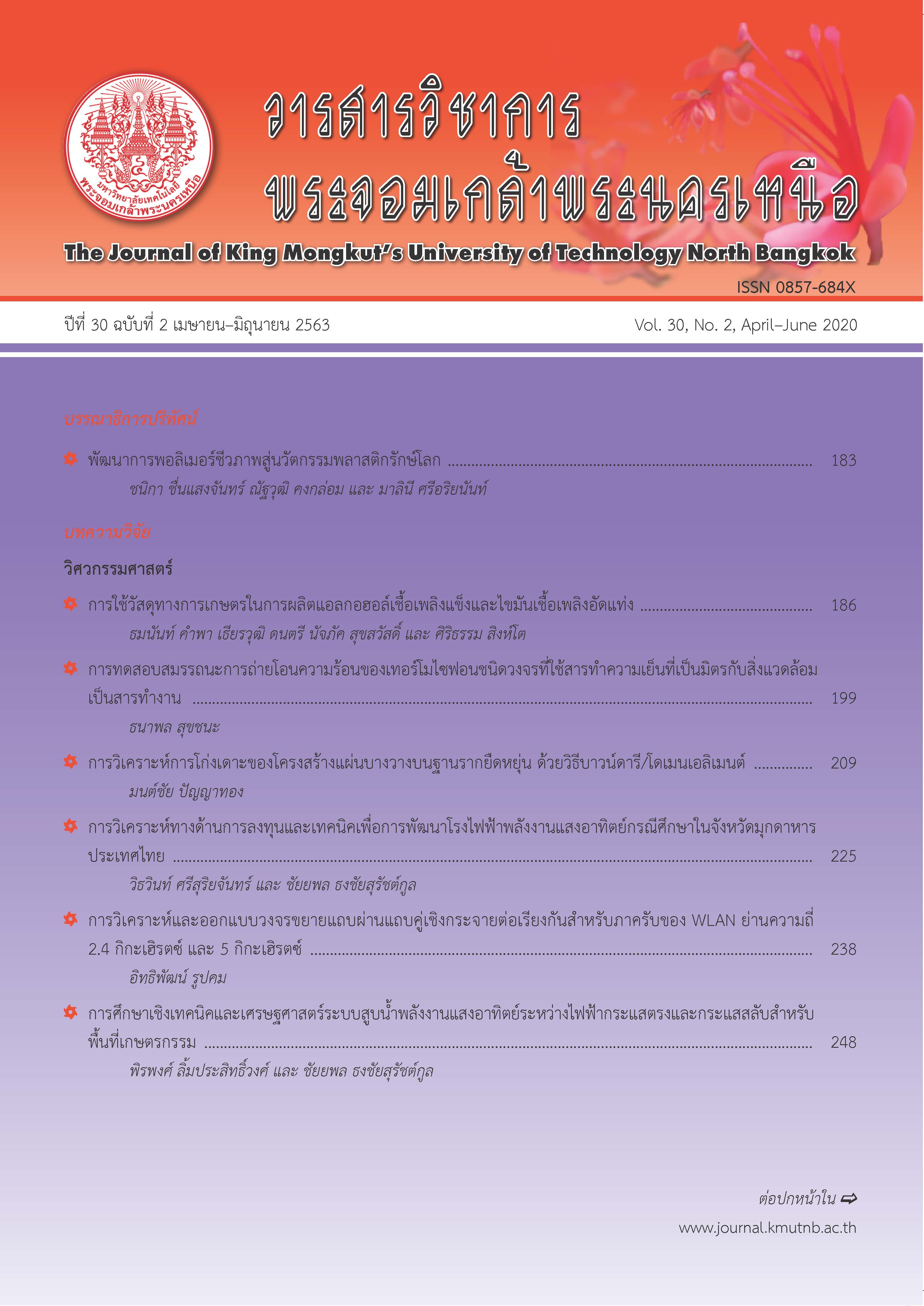แนวทางการพัฒนาพฤติกรรมการสร้างสรรค์นวัตกรรมของพนักงานที่มีต่อผลการดำเนินงานของวิสาหกิจขนาดกลางและขนาดย่อมในประเทศไทย
Main Article Content
บทคัดย่อ
การวิจัยครั้งนี้มีวัตถุประสงค์ เพื่อศึกษาแนวทางการพัฒนาพฤติกรรมการสร้างสรรค์นวัตกรรมของพนักงานที่มีต่อผลการดำเนินงานของวิสาหกิจขนาดกลางและขนาดย่อม โดยใช้ระเบียบวิธีการวิจัยและพัฒนา กลุ่มตัวอย่างที่ใช้ในการวิจัย คือ ผู้ประกอบการวิสาหกิจขนาดกลางและขนาดย่อมในเขตกรุงเทพมหานคร จำนวน 400 คน เครื่องมือที่ใช้ในการวิจัย ได้แก่ แบบสอบถาม ผลการวิจัยสรุปได้ดังนี้ ขั้นตอนที่ 1 การสัมภาษณ์เชิงลึกความคิดเห็นเกี่ยวกับแนวทางการพัฒนาพฤติกรรมการสร้างสรรค์นวัตกรรมของพนักงานที่มีต่อผลการดำเนินงานของวิสาหกิจขนาดกลางและขนาดย่อมในประเทศไทย จากกลุ่มเป้าหมายที่ 1 พบว่า พฤติกรรมการสร้างสรรค์นวัตกรรมประกอบด้วย 4 ด้าน คือ 1) ความคิดสร้างสรรค์ของพนักงาน 2) ความมีนวัตกรรมของพนักงาน 3) พฤติกรรมการปฏิบัติงานเชิงรุกของพนักงาน และ 4) พฤติกรรมการแสวงหาโอกาส ส่วนผลการดำเนินงานของ SMEs ประกอบด้วย 6 ด้าน คือ 1) กลยุทธ์และการจัดการองค์กร 2) โรงงานอัจฉริยะ 3) การดำเนินงานหรือการผลิตอัจฉริยะ 4) ผลิตภัณฑ์อัจฉริยะ 5) การบริการขับเคลื่อนข้อมูล และ 6) พนักงาน ขั้นตอนที่ 2 การศึกษาความคิดเห็นเกี่ยวกับการพัฒนาพฤติกรรมการสร้างสรรค์นวัตกรรมของพนักงานที่มีต่อผลการดำเนินงานของวิสาหกิจขนาดกลางและขนาดย่อม พบว่า 1) ความคิดเห็นเกี่ยวกับการพัฒนาพฤติกรรมการสร้างสรรค์นวัตกรรมของพนักงานของผู้ประกอบการ SMEs อยู่ในระดับมาก ( = 3.66, S.D. = 0.34) 2) ความคิดเห็นเกี่ยวกับผลการดำเนินงานของ SMEs เพื่อรองรับไทยแลนด์ 4.0 ของผู้ประกอบการ SMEs อยู่ในระดับมาก ( = 3.68, S.D. = 0.29) และ 3) การพ ัฒนาพฤติกรรมการสร้างสรรค์นวัตกรรมของพนักงานมีความสัมพันธ์และผลกระทบเชิงบวกกับผลการดำเนินงานของ SMEs และตัวแปรที่พยากรณ์ผลการดำเนินงานของ SMEs เพื่อรองรับไทยแลนด์ 4.0 ได้แก่ ด้านความคิดสร้างสรรค์ของพนักงาน (BEC) ด้านพฤติกรรมการปฏิบัติงานเชิงรุก (BBA) และด้านพฤติกรรมการแสวงหาโอกาส (BSOB)
Article Details
บทความที่ลงตีพิมพ์เป็นข้อคิดเห็นของผู้เขียนเท่านั้น
ผู้เขียนจะต้องเป็นผู้รับผิดชอบต่อผลทางกฎหมายใดๆ ที่อาจเกิดขึ้นจากบทความนั้น
เอกสารอ้างอิง
[2] B. Jay, “Firm resources and sustained competitive advantage,” Journal of Management, vol 17, no. 1, pp. 99–120, 1991.
[3] S. Maesincee, “Role of science technology and innovation with the endless opportunities of Thai startups,” Startup Thailand Magazine, vol. 11, pp. 1–24, 2018 (in Thai).
[4] Fiscal Policy Office. Thai Economic Forecast 2018. Bangkok: Fiscal Policy Office, 2018, pp. 131 (in Thai).
[5] Office of Small and Medium Enterprise Promotion (2013, Jun.). Situation of small and medium enterprises in 2013. Monthly report of small and medium enterprises, Office of Small and Medium Enterprise Promotion. Bangkok, Thailand [Online]. Available: https://www.sme.go.th/th/download.php?modulekey=215
[6] Office of the National Economic and Social Development Council. (2018, March). Thai economy four years, three years, 2017 and trends 2017-2018. Office of the National Economic and Social Development Council. Bangkok, Thailand [Online]. Available: http://www.nesdb.go.th/ewt_news.php?nid=7130&filename=index
[7] L. S. Kim and C. K. Hian, Balance Scorecard : A Rising in Strategic Performance Management. Chicago: NTC Publishing Group, 2001.
[8] G. T. M. Hult, R. F. Hurlay, and G. A. Knight, “Innovation: Is antecedents and impact on business performance,” Industrial Marketing Management, vol. 33, no. 5, pp. 429–438, 2004.
[9] N. Namburi, “Causal factors influencing innovation management and firm performance of the Thai palm oil mills and refinery industry,” Doctoral Thesis, Program of Business Administration, Ramkhamhaeng University, 2013 (in Thai).
[10] B. Jay, “Firm resources and sustained competitive advantage,” Journal of Management, vol. 17, no. 1, pp. 99–120, 1991.
[11] M. Piteira, “Professions in a changing world : The role of creativity,” in Proceedings International Sociological Association. ISA RC52 Interim Conference, 2013, pp. 28–30.
[12] M. A. Nisula, “Building organizational creativity - A multitheory and multilevel approach for understanding and stimulating organizational creativity,” Doctoral Thesis, Economics and Business Administration, Lappeenranta University of Technology, 2013.
[13] NESDC ECONOMIC REPORT, (2019, Feb.). Thai Economy in the Third Quarter of 2017 and the Outlook for 2017 - 2018. Office of the National Economic and Social Development Council. Bangkok, Thailand [Online]. Available: https://www.nesdb.go.th/ewt_w3c/ewt_news.php?nid=7130&filename=
[14] R. N. Richard and S. G. Winter, An Evolutionary Theory of Economic Change. England: The Belknap Press of Harvard University Press, 1981, pp. 452.
[15] D. J. Jeroen and D. D. Hartong. “Measuring innovative work behaviour,” Creativity and Innovation Management, vol. 19, no. 1, pp. 1–21, 2010.
[16] P. Wutthirong, “Five innovative organizations of Thailand : The differences in similarity of human resource management,” NIDA Development Journal, vol. 51, no. 3, pp. 35–57, 2011 (in Thai).
[17] Office of Small and Medium Enterprise Promotion, “The Plan to Promote the Accumulation of Small and Medium Enterprises 4 th (2017-2021),” Office of Small and Medium Enterprise Promotion, Bangkok, 2017 (in Thai).
[18] T. Yamane, Elementary Sampling Theory, 1 st ed. New Jersey: Prentice Hall, Inc, 1967.
[19] C. Khunphonkaew, (2018, Mar.). Innovation and Desirable Ability. Bangkokbiznews. Bangkok, Thailand [Online]. Available:http://www.bangkokbiznews.com/blog/detail/643700
[20] L. Khathutshelo and K. Y. Chan. “The perception of innovative organizational culture and its influence on employee innovative work behavior,” in Proceedings of PICMET’16: Technology Management for Social Innovation, 2016, pp. 972–977.
[21] B. Josh, M. Zaki, A. Neely, and F. Urmetzer, “Data and Analytics - Data-Driven Business Models: A Blueprint for Innovation,” University of Cambridge Combridge Service Alliance, 2015.
[22] U. Satiantip, “Intelligent organization : Learning organization,” KM Lite. vol. 4, no, 3, pp. 5–7, 2011 (in Thai).
[23] C. Gaewmaneechote, “Proactive personality, perceived organizational support and joy at work of sale staffs in one insurance company,” M.S. thesis, Department of Psychology, Faculty of Liberal Arts, Thammasat University, 2015 (in Thai).
[24] P. Charerk and K. Donkwa, “Employee engagement and innovative behavior of staff members at synchrotron light research institute (public organization),” Suranaree Journal of Social Science, vol. 8, no. 2, pp. 61–69, 2014 (in Thai).
[25] D. Jan and C. Ceylan, “Work environments for employee creativity,” Ergonomics, vol. 54, no. 1, pp. 12–20, 2011.

